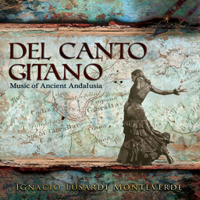
IGNACIO LUSARDI MONTEVERDE
DEL CANTO GITANO (ARC Music EUCD2929)
Monteverde is a London-based flamenco guitarist. Born in Argentina of Italian extraction, he now lives in Stoke Newington which is the part of London where the dissenters, people like Daniel DeFoe, lived. He works as a choir master but has also performed in India and Iraq as well as with classical Early Music groups. On this 2021 outing he set out to research the connections between Spanish music and that of India and North Africa, particularly as it manifest in the Renaissance. He knows his stuff and plays a variety of guitars adapted to the time period of each piece. It's well put together and shows a whole range of tonal palettes with voices and minimal percussion, building up a picture of Iberian music over the centuries. There's an Indian tanpura drone behind one piece, called "Rajasthan and Andalusia" which also has an Indian vocalist. It's not rigidly structured so you can hear flights of improvisation within each piece which makes it more organic and full of life than a performance based on a score.
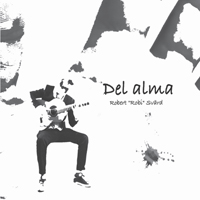
ROBI SVARD
DEL ALMA (Asphalt Tango Records CD-ATR6522)
This is the third release by the flamenco virtuoso from Sweden. Once again his breathtaking ability on the Spanish guitar is showcased, with a minimum of add ons. I imagine any kid who takes up classical guitar and becomes entranced by the challenging work of Isaac Albéniz (1860-1909) enough to master it, is halfway to understanding the complexity of flamenco. For Svärd's first album, Spanish virtuosos flocked to the studio to be part of the session, as they were so impressed with his Youtube presence. Now, thanks maybe to the pandemic, he has taken a more modest approach, with only vocalists and a few of his compatriots jumping in on harp or piano. Percussion is hand claps. The handclaps sound like (!) Miguel "El Cheyenne" from Granada who appeared on his previous disc. Svärd's playing is so versatile you'd think he is double-tracked. A Spanish violinist, Bernardo Parrilla, appears on the second track "Ciego de Amor (Blind love)," a bulerías which is very atmospheric, even suggesting at moments the flashing pyrotechnics of the Mahavishnu Orchestra. Next he offers a tango, "La luz del aire" which is light as air. Sandra Carrasco sings and Joel Lyssarides plays piano. Svärd gets many different tones out of his instrument, as heard on "Ecos de Albayzin." Albaicín is a medieval Moorish neighborhood of Granada. The nyckelharpa (a traditional Swedish chordophone, like a violin with keys) takes us from gypsy to celtic or nordic for the intro to "Danza de las nieblas (Dance of the mists)" as, again, a strong atmospheric dome covers the upwelling sounds, giving us two minutes of mood-setting before Svärd joins in with a delicate meditation. After 30 minutes the ensemble vanishes into the mists again, as it ends all too soon.
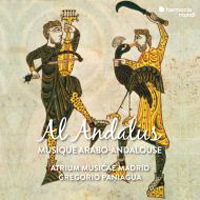
ATRIUM MUSICAE DE MADRID
MUSIQUE ARABO-ANDALOUSE (Harmonia Mundi 90389)
Recorded live in 1976, this is a magical journey. I first heard it on KPFA, my local community radio station when it came out, and had to buy it. It's medieval Arabic music as played in Spain and preserved in folk traditions for five hundred years. The Caliphate in Granada fell in 1492, just as Columbus sailed the ocean blue. The Arab influences were then subsumed into local Andalusian folk music. The ensemble consists of seven members (led by Gregorio Paniagua and features three of his family) but all of them play three or more instruments so they create a varied sonic tapestry, with pipes, tambourines, rabab (an Afghani lute), and darbuk. From the 8th to the 14th centuries, the Iberian peninsula was culturally the richest part of Europe. Removed from their stricter Muslim brothers in North Africa, the occupants of Iberia were into wine, women and song. A key figure was the Iraqi-born composer Ziryab who came to play. He devised suites of music divided into 24 Noubas to correspond with the hours of the day (like Indian ragas). Most have been lost but his chief legacy is the lute which he invented, adding a fifth string to a traditional instrument (Unlike the oud, the lute is fretted). Reinterpreted Greek and Persian musical theories gave birth to modern Christian music, such as plainsong. Listening to this you can envision the sparkling tile work, the water rippling down the walls into the pool in a warm evening (yes the water is audible in the recordings!), the sinuous moves of the dancing girls. The album is a shimmering mosaic of beautiful fragments as long-dormant compositions rise before us on qitar (drum), ud (oud, plucked with a feather), bug (small flute), qanun (zither), ghaita (bagpipe!), kamanjeh (viol), rebec (another bowed string instrument) and darbuka (ceramic & goatskin goblet drum). The album has long been popular: one listening will convince you of its beauty, and so Harmonia Mundi is reissuing it.
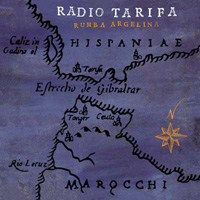
RADIO TARIFA
RUMBA ARGELINA (World Circuit)
Radio Tarifa burst out of Madrid, Spain in 1996, with this, their debut album, now reissued on vinyl. The concept behind the band was to imagine a radio listener in Cape Tarifa, on the southernmost tip of Spain, who can hear music from across the Mediterranean in North Africa. Of course Spain's music is imbued with Arabo-Andalusian strains as well as rich local traditions such as flamenco. There's accordeon, woody flute (ney), derbouk, dashes of radio static, and a wonderful dreamy ambience. I saw them on their first tour and loved them, but was disappointed their subsequent albums didn't keep this spark burning quite as brightly. This one is heavy on the classics of the Arabo-Andalus repertoire, mixing guimbri with viola. The fine trilling Spanish guitar comes to the fore on "Tangos del agujero" which also features tablas. But we soon return to the medieval instruments (fidula and crumhorn) and what I believe was called "oriental" music in the olden tymes. This is moody, fine music of a high order. It gets heavy without being ponderous, due to a fine audio mix by composer and multi-instrumentalist Fain Dueñas.
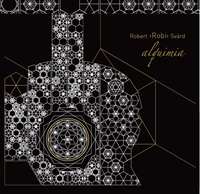
ROBERT 'ROBI' SVARD
ALQUIMIA (Asphalt Tango CD-ATR 5918)
Robi Svärd's first foray into flamenco was so stunning it was unlikely a follow-up could live up to it. Nevertheless, the Swede has now established himself as a major figure in the world of Spanish guitar. Two years ago his debut Pa'ki pa'la blew away the establishment when he showed that an outsider could excel in the heart of one of the most jealously protected musical domains. The guardians of the tradition had no option but to embrace him and on this outing he has as many as twenty guests lining up to clap hands, stamp feet or accompany him in whatever capacity they can. "El Potito" Antonio Vargas sings on "Bajo la luna." Flamenco singing always sounds to me like complaining drunks, but "beneath the moon" I guess that's your best option. "El Cheyenne" plays percussion. These people are so famous even the hand-clapper has a nickname: "El Moreno," and on chorus we hear "El Quero," "El Negro" and "Cheyenne junior." This one fades suddenly and we are back to the basking joys of Robi's florid guitar and now even the moon wants to dance. After this tango we hear "Soñando," a "detalle por rondeña," which is a musical form I have never heard of before but it is exquisite. Svärd plays trilling leads on the top strings and a bass with his thumb. There's an acoustic bass and a harmonica sneaks in unobtrusively. The biggest surprise is the appearance of duduk on "Nor jugha" -- this is an Armenian double woodwind, which I suppose has a distant connection to Galician gaita or bagpipes. It makes a lovely counterpart to the bright bristling guitar. "Te Vienes O No Le Vienes (Are you coming or not)?" quotes bits of "Fly me to the moon," which seems to be a theme here. A guest guitarist is allowed to join in for the last quiet fade as they go gentle into the good night.
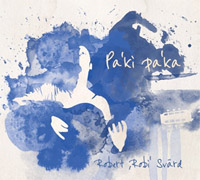
ROBERT "ROBI" SVARD
PA'KI PA'KA (Asphalt Tango ATR 5416)
This is lovely. I mean truly lovely, or in the words of one song title, "Dulce maravilla." It's acoustic guitar flamenco, which is about as naked as a guitarist can get. No studio effects, no double-tracking, no malarkey with pedals and gizmos. Robi Svärd, as you might guess, is not Spanish but Swedish. He so impressed the flamenco community with his guitar-playing that he was invited to Granada to perform and record, and in fact many legendary figures showed up in the studio and mentioned they might be willing to clap or sing if needed. Or to be strictly accurate they first showed up on YouTube, when Robi posted a video of his playing, and Alfredo Tejada left a comment saying he would like to sing with him, and indeed he does sing on three of the tracks here. His breathy/hoarse delivery adds suitable electric tension to the atmosphere. I am guessing the title means "Here and there," implying that Svärd is happy wherever he is, but the recording was made at the home of flamenco: Granada's FVR studios where, not by coincidence, the legendary percussionist Miguel "El Cheyenne" also added his chops on cajon, pandero, djembe, and handclaps -- the all-important "palmas." He also shakes some things and rattles others. Other instruments appear sparingly: cello, oud and bass, and a dancer too: you have to have a dancer. I imagine a red flounce dress with polka dots. Black or white, take your pick. Svärd features rumbas, bulerias, alegrias, tangos, a guajira, and the last track "Paseo de los Tristes," described as a granaiana, which is an arhythmic form. In other words you can't dance to it, you just stand and listen in wonder. There is so much joy imbued in these tracks you can hear the performers laughing at themselves in amazement at the end of the title cut. Svärd's freshness, his unique approach to the tradition, inspires the others to excel. There are breath-taking passages and really memorable melodies.
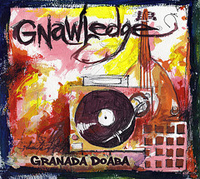
GNAWLEDGE
GRANADA DOABA (Gn7)
What we have here is a group with a bad name and a CD with an unmemorable cover. But it turns out this is a very engaging album. It's not all brilliant but there are flashes of genius. It sounds like a radio programme: it is diverse and really well sequenced. It starts out flamenco and you think, OK, Spanish guitars, how much of this can we take? But pretty soon there's dub with clarinet, cajon and laud, then beats & samples are layered on, with all sorts of fun treats and it keeps getting better. And you can judge for yourself, because on their website they offer you a free download of the album and urge you to copy, share and remix it. Now that's a smart business move. They know they can't make money through record sales but if enough people hear the music they will get their message across. Granada Doaba is the brainchild of two Americans: Canyon Cody, who got a Fulbright to go to Spain and research the roots of Flamenco and Sean Dwyer who arranged the beats. The two started Gnalwedge Records in Boston in 2004. In Granada they rented a space and invited locals to drop by and dance or play music, with great success. Luthier Uzman Almerabet is noteworthy. The CD has a signed hand-sewn (by Cody's mom) collage booklet with stickers and rubber stamps. Charmed, I'm sure. Highlights for me are the unknown singer doing "No te rebeldes," accompanied by a pair of Japanese, and the sleek remix of the Peanut Vendor, "El Manisero de Potemkin." Mil gracias! Another surprise is in the track "Juxtapotente": darbouka is credited but the sound you hear is a sitar.
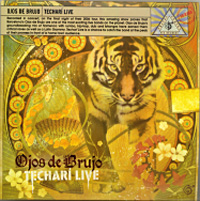
OJOS DE BRUJO
TECHARI LIVE (Diquela Records/Six Degrees in USA: bar code 657036 1144 2 5)
It makes sense for Spanish collective Ojos de Brujo to release a live album since they are such dynamic performers. This album was recorded at the end of their 2006 tour. They have flashes of flamenco, electronica, hip hop, even reggae, and it sounds like a sonic stew but it works. The percussion keeps it together and though their gypsy guitarist gets buried in the mix on stage you sense he is driving from the back seat. Radio Tarifa were disappointing on their live album Fiebre, but Ojos show they can take it on the road and bring it back polished to a high sheen. After touring behind their Latin Grammy-winning Techari album they returned to Barcelona for a triumphal show which is also released on DVD (to be included in the package). I wish they had left off "Get up, stand up" which always sounds lame when bands try too slavishly to recreate the Marley sound, but after this pot hole they get back to what they do best: cooking their musical olla podrida with hints of Middle Eastern music (even as far as India), African and Afro-Cuban swirling around the Spanish guitar (which is audible on this clean recording). Tablas and muted trumpet float through without detracting from a slamming salsa finish to "Piedras vs Tanques." At home they are able to bring up more members of their collective so there is a full horn section, a luxury they could use on the road. They break into a refrain of "Como su rythmo, no hay dos," repeated ad lib as a montuno piano and the big horn section materialize. The concert ends there but we have to endure another take of "Get up, stand up" (studio) which is not so bad as it evolves into a flamenco, & a remix of "Nana," a delicate Andalusian-sounding song from Techari which is a good night cap to this set. The remix is by Palyrria who are Greek and they are playing lute, lyre and percussion, but somehow the Arabo-Andalus feeling comes through to my ears.
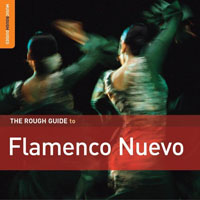
ROUGH GUIDE TO FLAMENCO NUEVO (RGNET 1170 CD)
Listening to flamenco on CD always struck me as akin to listening to a ventriloquist on the radio. But if you are fortunate to see Antonio El Pipo in concert, you will be thrilled. This new Rough Guide shows Flamenco as a genre moving along progressive paths as it encompasses other ideas while keeping its essential truth. Originally brought by the gypsies from India in their long migration in the 12th to 14th centuries, it was impacted by the Moorish culture it encountered in Andalucia. The tradition is intact as heard in Jeronimo's "Wolfgang Amadeus Mozart." This young virtuoso is only in his twenties but has shared a bill at Carnegie Hall with Paco de Lucia. The new sound is exemplified by Ojos de Brujo, who fit snugly between more traditional and more far-out pieces. There's still plenty of foot stomping and flamboyant skirling strings. Mexican-born, Irish-based guitar duo Rodrigo y Gabriela remind me of Tommy Bolan in his excessive heyday. Digitano pushes the envelope with his Cuban-heeled boot, throwing beats and synth riffs at the traditional vocals of Eva Duran, but the weirdest thing on here is Grandmaster Flash remade as Spanish hiphop by Diego Carrasco on "Asereje." It was a hit in the Spanish-speaking world about three years ago for a girl group called Hijas del Tomate, whose CD LAS KETCHUP had three versions of the song. Composer Manuel Ruiz made Spanish pidgin out of the lyrics, "I said hip hop hip to the hippity hop to the hippity beat!" which now goes, "Asereje ja de je dejebe tu de jebere seibiunouva, majavi an de bugui an de buididipi." A Spanish-speaking friend tells me they are supposedly devil-inspired lyrics! This pleasant Iberian trip ends with a Ladino ballad sung/yelped by Yasmin Levy, her voice full of the anguish of Jewish exiles who ended up, like the gypsies, in Spain in the middle ages and wondered if they missed the turning.
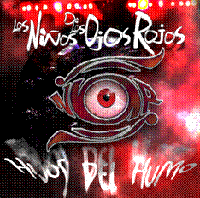
LOS NINOS DE LOS OJOS ROJOS
HIJOS DEL HUMO (Extremedios CD)
More Iberian madness. This CD doesn't suffer from a lack of information but a seriously warped sense of design that renders the liner notes completely unreadable. You see that red eyeball on the cover? That's how you'll feel if you attempt to read this: the text is set in 6 point script type that has been half-toned. If this is a joke on the band's name I am not amused. In addition (if that wasn't bad enough), it's in yellow or silver (hard to tell) and run across the photos which are half the size of postage stamps. The flautist is the art director for the band. Enough said. Through the murk (compressed photo to get everyone in; smoke-effects added in Photoshop) they seem to be wearing kilts, so does this mean they are a Celtic band? There's an obvious parallel to Ojos de Brujo: similar instrumentation, including a mixologist playing live. There are some trippy effects but enough good musicianship (Mario Lopez on spanish guitar and Jasmin Mesic on bass) to impress you. On "La Charca'l tesoro" it's only a matter of time till the electric lead guitar stumbles into "Purple haze"! "Smo-kin blu" starts with poppin' Stanley Clarke bass, adds Irish jig fiddle and gratuitous flute then drops in a ska vocal. Quite a cocktail, and you don't want to be smoking blue or anything else if you are tryna keep up with this. Obviously they have worked this up in concert. All of the material is polished and suggests years of tight interplay and intuitive forays by soloists. We are even treated to a touch of "Asturias" in the middle of "Moja mala" which starts out moody and ends in another ska-gypsy rave-up. They stray to the Balkans for "Evo banke," demonstrating that all folk music is grist to their mill. (Though what one does with freshly ground grist I am not sure.) Massively talented with a sense of humour, the Red-eyed Kids are musical over-achievers. All in all it's quite exhausting, but if you are in your 20s this is just the ticket to keep you dancing all night.
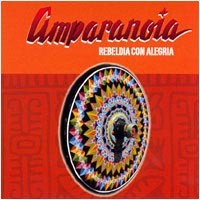
AMPARANOIA
REBELDIA CON ALEGRIA (Capitol/EMI [typical endless corporate barcode catalogue numbers])
Will someone explain what's going on in Spanish music? Right now it is on fire. Every new act from there, from Radio Tarifa to Ojos de Brujo, is gripping. Now I latch onto Amparanoia and it's the best yet. This is their fifth or sixth album, though they just won the Newcomer Award from BBC Radio 3. and apparently it's a "best of" assembled from their previous recordings. They are fronted by a woman, Amparo Sanchez, who writes the songs, and sings and plays guitar with passion. Her hero is Billie Holiday. Manu Chao, on hearing her, said she swallowed a microphone at birth. The arrangements are complex and full-bodied, strongly flavoured with catchy melodies. Ranchera, salsa, polka, gypsy swing ("Somos viento"), tango ("Don't leave me now"), music hall ("La fiesta") or novelty -- you name it, they seem to have mastered it. Several songs on here sound like "hits," from the up-tempo danceable "Somos viento" to the sing-along stadium rocker "Caravane." Maybe it's because they have great hooks and make their point then quit in three or four minutes. There's a hard-ass version of "Dos gardenias para ti" which is what the world needs to blow off those buena vista cobwebs. "Trabajar" is moody and spacey and segues into salsa with blues harmonica for "Buen rollito," a song with the chorus "Welcome to Tijuana: tequila, sexo y marijuana." There's no writing credit on the promo CD I got so I can't tell who wrote this, but imagine a Cuban version of the Clash and you get the picture.
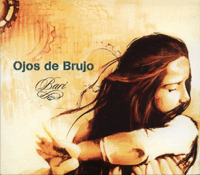
OJOS DE BRUJO
BARI (World Village 468024)
I am guilty (but not alone in this apparently) of prejudging the Ojos de Brujo album, BARI. There was so much hype in anticipation of this album -- a music video premiere on WorldLink tv, a big ad in Songlines with an overly cute photo of the singer looking like she'd smelled a fart, and of course the obligatory BBC Radio 3 World Music Award for Best New Artist -- that I thought it had to be over-rated. But I admit I was wrong. It is a superb example of the future of Spanish music with flamenco colliding with some other less-traditional forms. There's a bit of Radio Tarifa which makes it as palatable as sugary Sangria. Excellent musicianship, interesting vocals, and high production values combine to augment the variety of approaches. The Hispano-Moresque connection is highlighted on "Calé Bar'92" when the great Cheick Lô pops in for some high-level wailing. There's also great jazz trumpet and a reggae breakdown on this fluid track. I bet it's great live. All the tracks have guitar, bass, cajon and shouting! Truly a great album.
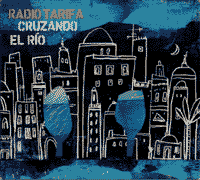
RADIO TARIFA
CRUZANDO EL RIO (World Circuit/Nonesuch)
We step off the African continent at the closest point to Europe: southern Spain, to listen in on the third installment of Radio Tarifa, CRUZANDO EL RIO. You may know the concept behind the band: imagine a radio station that could be heard in North Africa and Southern Spain that fused the musical traditions of those countries, which were one and the same a millennium ago when the Moors ruled the roost in Andalusia. I have vivid memories of the great show they put on at Slim's in San Francisco a couple of years back. It was a very hip crowd who were respectful of the music (apart from Lulu of course who was stamping, clapping, yowling and yelping like suddenly the flamenco demons had possessed her & were urging her to breathe fire). The ten musicians were all masters of their instruments and though the music was drawn from the traditional bag there was no mustiness to it: they jammed. Now however, the group has been pared down to the three founding members (via multi-tracking). I miss the pulsing bass and the driving rock rhythm that created an edge to their first two albums. It's there but only audible to a smaller degree. The title cut starts with insect sounds and moves to a tango beat but as soon as the groove kicks in, it fades out. "La Molinera," a traditional Castilian song in 5/8 time, has a Robert Fripp-influenced Les Paul guitar solo played against the traditional instruments. The music is still beautiful and delicate but much more contemplative. The sparseness (bleating wind instruments -- bagpipes, Egyptian double clarinet and comormo -- against plangent oud or guibri) almost makes it sound like Japanese koto music. This may seem far-fetched but they do indeed include "Gujo bushi" -- a modal piece from Japan! I'm giving CRUZANDO EL RIO two thumbs up even though the album ends morbidly with a fifteenth-century organ and oboe recitation, "Si j'ai perdu mon ami." The BBC deejay Charlie Gillett is credited with re-sequencing the album. Whatever the earlier sequence, it would have been better not to end on a down note. While it doesn't have the catchy hooks of their first album, RUMBA ARGELINA, CRUZANDO EL RIO is solid and merits repeated listening.
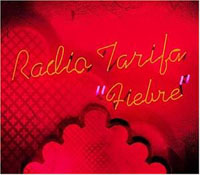
RADIO TARIFA
FIEBRE (Nonesuch 79822-2)
Radio Tarifa's first album was truly superb, and the fact that six of the twelve songs on this live set are from it shows that they thought so too. The second album was also good but the third one less so. A decade later they reprise their moment of glory with a live album recorded in Toronto, but the magic has gone somewhat from their sound. They were great live when they toured almost ten years ago to promote their first album, however I believe they have had personnel changes since then. This album lacks oomph. Maybe they were nervous, knowing it was being recorded for posterity, but that shouldn't discourage them. The originals have more spark. "Oye china," which is haunting on the original album, just sits flatly and looks at you, not even recalling the peanut vendor with a smirk like it should.
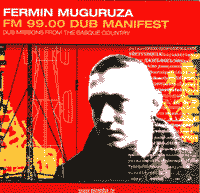
FERMIN MUGURUZA
FM 99.00 DUB MANIFEST (Piranha CD1571)
Fermin Muguruza is a ska singer from the hilly Basque country that bridges France and Spain in the Pyrenees. His band Dub Manifest has a real ska party vibe going like the Specials in their prime. They must play tiny crowded hall s from which there is only one narrow egress (hence the expression, "Don't put all your Basques in one exit")... anyway, as I was saying, there's a great loose, beer-drinking skanking sensibility at work here with trumpet and trombone and occasional accordion, and of course lots of "take it down to the bare bones and turn up the Echoplex." FM 99.00 DUB MANIFEST on the excellent Piranha label is up-tempo, danceable and diverse with politically engaged lyrics. In a nod to John Sayles' film MEN WITH GUNS, Muguruza quotes the only Mayan member of Mexico's congress: "People without information are dead people." He sings about conquest in "Dirty Spanish money" which depicts the well-known thieves, rapists and murderers Cortez, Pizarro and Columbus. If you dig good dub from Dennis Bovell to Lee Perry you will enjoy this production.